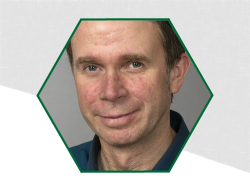The CYCLAM-technique carries out additive manufacturing by sequentially transferring drops from a solid donator, which can even be metal waste, to the part to build up. The drops are detached by continuous melting followed by melt acceleration from the ablation pressure during laser-induced boiling. Either cutting or other process variants like ejection from the edge or from the surface can be carried out to separate drops. In 2017, a feasibility study has demonstrated, for austenitic stainless steel with a 6 kW fibre laser beam under optimized process conditions, that continuous tracks can be deposited. Sheets of 1-3 mm thickness were cut and the substrate was placed 2-10 mm under the donator sheet. High speed imaging has shown that the melt first moves as a liquid column downwards and within 1-4 mm breaks into drops, probably by surface tension governed Plateau-Rayleigh instabilities. The drops keep a quite regular size and flight trajectory and deposit in seuqnce at the substrate, forming along melt pool. The technique needs to be explored and mapped further. CYCLAM offers advantages to avoid powder or wire making and its handling, while instead to basically use any solid metal available. The technique can become very cost and resource efficient as well as environmental friendly.
Continued studies were made for further steel grades, for which the sequential transfer of large drops remained quite similar, as observed by high speed imaging. The drop diameter was 0.5 mm in average and the average drop velocity was 2 m/s. Specific steel grades could be studied for AM that are not available as powder, which enabled to study certain metallurgical mechanisms. Even titanium was studied, which behaved similar to steel, owing to widely similar physical properties.
When studying the CYCLAM-technique for aluminium alloys, of the groups AA5XXX, AlMg, and AA6XXX, AlMgSi, the melt movement behaved very differently. Because of the high absorptivity and conductivity high laser beam power and power density was required to achieve boiling. Small droplets were ejected both at the top and bottom of the sheet while most of the melt reunified, behind a distinct keyhole, instead of being ejected. Small droplets can even solidify during the flight and bounce back from the substrate instead of being incorporated. Moreover, aluminium tended to deformations of regions surrounding the processing zone. Aluminium requires therefore different approaches compared to steel or titanium, to be further explored.
Keywords
- Aluminium
- Cyclam
- Drop Transfer
- High Speed Imaging
- Lam

